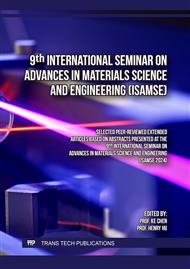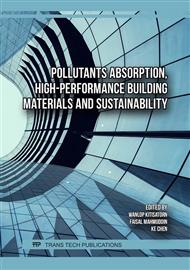[1]
Li, X. B., Wei, X. I. A. O., Wei, L. I. U., et al. (2009). Recovery of alumina and ferric oxide from Bayer red mud rich in iron by reduction sintering. Transactions of nonferrous metals society of China, 19(5), 1342-1347.
DOI: 10.1016/s1003-6326(08)60447-1
Google Scholar
[2]
Yi, Y. A. N. G., Guo, Y. Q., Zhu, W. S., et al. (2019). Environmental impact assessment of China's primary aluminum based on life cycle assessment. Transactions of Nonferrous Metals Society of China, 29(8), 1784-1792.
DOI: 10.1016/s1003-6326(19)65086-7
Google Scholar
[3]
Milačič, R., Zuliani, T., & Ščančar, J. (2012). Environmental impact of toxic elements in red mud studied by fractionation and speciation procedures. Science of the Total Environment, 426, 359-365.
DOI: 10.1016/j.scitotenv.2012.03.080
Google Scholar
[4]
Liu, W., Chen, X., Li, W., et al. (2014). Environmental assessment, management and utilization of red mud in China. Journal of Cleaner Production, 84, 606-610.
DOI: 10.1016/j.jclepro.2014.06.080
Google Scholar
[5]
Yao, X., Zhang, Z., Zhu, H., et al. (2009). Geopolymerization process of alkali–metakaolinite characterized by isothermal calorimetry. Thermochimica Acta, 493(1-2), 49-54.
DOI: 10.1016/j.tca.2009.04.002
Google Scholar
[6]
Louati, S., Baklouti, S., & Samet, B. J. A. C. S. (2016). Acid based geopolymerization kinetics: effect of clay particle size. Applied Clay Science, 132, 571-578.
DOI: 10.1016/j.clay.2016.08.007
Google Scholar
[7]
Celerier, H., Jouin, J., Tessier-Doyen, N., et al. (2018). Influence of various metakaolin raw materials on the water and fire resistance of geopolymers prepared in phosphoric acid. Journal of Non-Crystalline Solids, 500, 493-501.
DOI: 10.1016/j.jnoncrysol.2018.09.005
Google Scholar
[8]
Tchakouté, H. K., Rüscher, C. H., Kamseu, E., et al. (2017). Influence of the molar concentration of phosphoric acid solution on the properties of metakaolin-phosphate-based geopolymer cements. Applied Clay Science, 147, 184-194.
DOI: 10.1016/j.clay.2017.07.036
Google Scholar
[9]
Ara, A., & Usmani, J. A. (2015). Lead toxicity: a review. Interdisciplinary toxicology, 8(2), 55-64.
Google Scholar
[10]
Blanco, A., Pignata, M. L., Lascano, H. R., et al. (2021). Lead uptake and translocation pathways in soybean seedlings: the role of ion competition and transpiration rates. Environmental Science and Pollution Research, 28, 20624-20636.
DOI: 10.1007/s11356-020-11901-x
Google Scholar
[11]
IS10500, B. I. S. (2012). Indian standard drinking water–specification (second revision). Bureau of Indian Standards (BIS), New Delhi, 1-11.
Google Scholar
[12]
Al-Swadi, H. A., Al-Farraj, A. S., et al. (2023). Kaolinite-composited biochar and hydrochar as low-cost adsorbents for the removal of cadmium, copper, lead, and zinc from aqueous solutions. Sustainability, 15(22), 15978.
DOI: 10.3390/su152215978
Google Scholar
[13]
Ai, T., Zhong, D., Zhang, Y., et al. (2021). The effect of red mud content on the compressive strength of geopolymers under different curing systems. Buildings, 11(7), 298.
DOI: 10.3390/buildings11070298
Google Scholar



